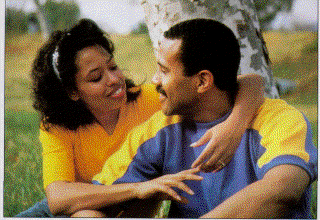Family: In Marriage… 1 + 1 = 1
When it comes to marriage, the Bible’s first book says 1 + 1 should equal 1. It tells us two “I’s” must become one “we” if a marriage is to thrive. Marriage counselors and psychologists who study healthy marriages agree.
 EXPERTS FIND “WE-NESS”
EXPERTS FIND “WE-NESS”
In one classic analysis, social historian Jeanette Lauer and her husband, Robert, a specialist in human behavior, studied couples with enduring marriages. Among the couples the Lauers studied were 300 who had been happily married for 15 years or longer.
The Lauers described in an article in Psychology Today how the couples reflected a we-ness approach to their marriages. The couples made many “we” statements when describing their married life.
“We agree on aims and goals.” “We laugh together.” “We agree on a philosophy of life.”
“We share outside hobbies and interests.” “We agree about our sex life.”
“We have a stimulating exchange of ideas.” “We agree on how and how often to show affection.”
“My spouse is my best friend.” “I like my spouse as a person.” “I confide in my spouse.”
The happily married couples studied by the Lauers tried to do as many things together as possible. One husband said of his wife: “I would rather spend time with her, talk with her, be with her than with anyone else.” Another said: “We try to share everything.”
For these couples, said the Lauers: “‘Till death do us part’ is not a binding clause but a gratifying reality.”
U.S. psychologist Nick Stinnett and John DeFrain, his colleague, have conducted studies of what they call “strong families.” More than 3,000 families from all around the world contributed to the research and conclusions these authors described in the book Secrets of Strong Families.
They found that these families had several characteristics in common, in spite of the fact that they lived in such far-flung corners of the earth as the United States, Central and South America, South Africa or Germany, Austria and Switzerland.
The we-ness factor loomed large as binding glue in their marriages. “Members of strong families feel good about themselves as a family unit or team,” wrote authors Stinnett and DeFrain. “They have a sense of belonging with each other — a sense of `we.'”
One husband said: “It came to me that the joy of life comes from the two of us together rather than outside things like career, hobbies, or leisure activities.”
Strong families do not let careers slash into marriage bonds. Said one wife: “My husband and I decided that family is very important to us. Our relationship and our relationship with our children will outlast jobs and cars and houses.”
These husbands and wives are first and foremost “we-always” couples. They are, we might say, wired together. “They share all (or nearly all) aspects of their lives with interest and joy,” wrote Stinnett and DeFrain. They are mates, lovers, companions, partners, and best friends.”
BIBLICAL ONENESS
The biblical perspective — what God says about the relationship he created — also tells us that we-ness is central to marriage. The tie that binds is described in Genesis 2-24: “A man will leave his father and mother and be united to his wife, and they will become one flesh.”
The modern English paraphrased Living Bible says that a husband and wife are joined together in such a way that “the two become one person.” A husband and wife are not merely two separate selves who happened to sign a marriage document. They make up a new oneness — a “couple.”
That oneness is not just a nice thought — it is real. Many of us have had the sad experience of seeing longtime friends who have divorced. Something about each of the former spouses seems missing. Professor Robert C. Roberts of Wheaton College and his wife, Elizabeth, had this same reaction, one they described so eloquently in Christianity Today magazine. They wrote; “We say, ‘Hi Joan. How’s … ?’ We catch ourselves, and we have an impression that the divorce means not just that Harry is no longer a ‘part’ of Joan’s life, but that this is not quite the old Joan, either. A dimension of her had been amputated.”
This is what Genesis 2:24 is telling us. A real bond exists between a truly happily married couple. In fact, this God-created relationship must be present and growing if the marriage is real, and if it is to work.
| “Members of strong families feel good about themselves as a family unit or team,” wrote authors Stinnett and DeFrain. “They have a sense of belonging with each other — a sense of `we.'” |  |
LEAVE, CLEAVE, WEAVE
It’s been observed by Christian leaders, including Luis Palau, that failed marriages do not follow the formula given in Genesis. First, the partners do not leave their parents in a broad sense. They are still holding on to past unhealthy attitudes, beliefs, desires and needs.
Neither are they cleaving to their partner, in all that this represents. They still think of themselves as “I” first. As a result, these couples do not develop a unity in their relationship. Dr. Palau’s advice to such people in the book Husbands and Wives is: “Leave. Cleave. Unify.”
Gary Bruland says the same thing. Based on Genesis 2:24, he describes in slightly different terms the same threestep process couples go through in order to create a spiritually healthy marriage bond. He says in a Preaching Magazine sermon that they must: leave, cleave and weave.
Paul defined this interweaving oneness in his letters. He spoke of it in the context of the sexual union between husbands and wives. Paul wrote: “The wife’s body does not belong to her alone but also to her husband. In the same way, the husband’s body does not belong to him alone but also to his wife” (1 Corinthians 7:4). That is a powerful example of the we-ness factor at work in a couple’s life.
In another epistle, Paul described the marriage bond as a metaphor for Christ’s love for his church (Ephesians 5:22-33). Of this union, Paul said, “This is a profound mystery — but I am talking about Christ and the church” (verse 32).
JESUS & THE MARRIED COUPLE
Ephesians 5 tells us that a bonded marriage stands as a symbol for the intertwining relationship between Christ and the Church. In this context, Dr. Palau observes: “Christian marriage is really a triangle: a man, a woman, and Christ.” The Christian marriage then, ought to be a uniquely “we” sort of relationship.
Every truly bonded marriage is a relationship by definition. A license, a ceremony, an exchange of vows, a blessing, even living together does not create a marriage. A marriage is a cleaving and weaving relationship. It is a God-created we-ness between two people who experience themselves as one, and act accordingly.
James Olthuis of the Institute of Christian Studies in Toronto summarized it as well as anyone: “Marriage is the ultimate human connection in which two people commit themselves to each other in a lifelong communion of sharing and caring.”
The first connection is made when two people of the opposite sex meet. Additional cords are strung as the couple spend time with each other and interact. A strong bond begins to take shape and the couple marry. Throughout life, the bond grows and grows into a massive steel cable of ever-increasing strength.
The weaving, however, is never complete. In the words of the Roberts: “Becoming one flesh does not happen on the wedding day (or night), nor is the process very likely ever to be complete. It is a calling of Christian couples, a destination toward which they ever travel.”
